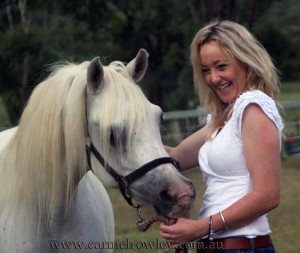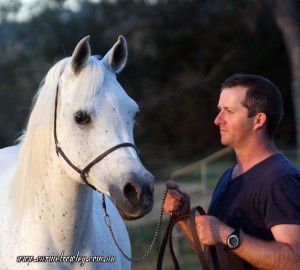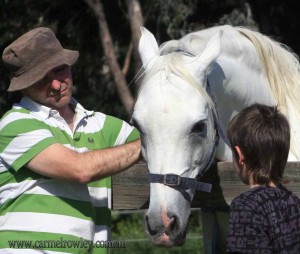Feel great with a horse … Carmel Rowley
Horse lovers can close their eyes and envision – galloping horses – thundering hooves – manes and tails streaming out behind. Horses have been racing for their lives for more than 50 million years. But once humans found horses not only did man’s world change but an amazing connection was created.
Six thousand years ago, horses were domesticated and since, they have fired our imagination and grabbed a firm hold of our hearts. More than two hundred breeds have been created, from the working Clydesdale to the desert Arabian. Horses have been shaped by man for any manner of duties, whether on the battlefield, pleasure riding, hunting, or simply working the family farm. Horses were relied upon and proved themselves as dedicated, sensitive and much adored companions.
But why are we able to control horses at all when they are so much stronger than humans? We who own horses know they don’t learn the way we do, we know they are creatures of flight, they are prey animals with highly sensitive natural instincts.But it’s the herd instinct, the forming of family groups and an understanding of the herds hierarchy which appears to make them amenable to learning what humans want them to do.
One of the most miraculous things I’ve had described to me is how horses are used to assist people to confront their fears and heal the trauma in their life- Can you imagine a horse as a life coach? This is exactly what some horses are used for and the success of such therapy is astounding. A dear friend of mine described such sessions over a get together for lunch some months ago and I was enthralled by what she told me.
Imagine my excitement when my Oprah Newsletter arrived with a similar type of story – written by Martha Beck – describing the inspirational Koelle Simpsons, Equine Therapy, titled Meet Your New Therapist. He’s Wise, Compassionate…and Likes to Eat Hay. http://www.oprah.com
I know you will adore this article so I’ve included some excepts below. Apparently there are more than 58 million horses in the world today, and there is no reason to assume that these numbers will dramatically decrease any time soon. One thing that I do feel ‘as a given’ is that the continuing bond between horses and humans will remain strong for many, many years to come.
Here is the the link to Oprah’s Newsletter: http://www.oprah.com/spirit/Koelle-Simpsons-Equine-Therapy/1#ixzz2bTSiDzmu
But a horse’s panicky instincts are balanced by an equally intense desire for companionship. Since a lone animal is like a walking buffet, horses desperately need one another for protection and constantly exchange social cues, giving affection, setting boundaries. Anxiety, rage, and other unsettled emotions feel dangerous to them, and they’ll do whatever they can to escape such frightening energy. If that means edging away, they’ll edge. If it means running, they’ll run. If it means rearing, kicking, or biting, that’s what they’ll do. But no horse ever sets out to be violent. They lash out as a last resort—much like we do when we feel tied up and cornered by social obligation, financial pressure, the endless demands of our daily lives.
The similarities between equine psychology and human psychology mean that interacting with horses can tap into some of our deepest emotions. Throughout history, horses have been whipped, hobbled, dragged, and otherwise tortured until they go numb to their instincts and agree to do whatever humans want. This may sound familiar. How many times have you felt the lash of disapproval, the hobbling of your heart’s desires, the torture of others’ expectations?
Humans who can “speak” in the gestural language horses use to communicate with one another have demonstrated that these animals are amazingly cooperative. They’ve also found that horses always tell you exactly what they think—and here’s where things get interesting, because what horses think of you happens to be what most people think of you, too. The difference: Horses won’t lie about it. Flattery, backstabbing, and hidden agendas are unknown to horses. They communicate what they feel, straight up, all the time. Which means that to gain their trust, humans must be genuine, clear, and honest. Which is why horse whispering is such a powerful psychological intervention.
“Exactly what he’s doing,” says Koelle. “Within the limits of the situation, horses will always do what they want.”
Ernie is an average-size horse, which is to say about ten times as heavy as Avery. He could accidentally crush her foot with a casual step. One solid kick (which Ernie has no intention of delivering) could cave in her skull. And so when he whinnies, trying to call his herd—a sound as loud as a car alarm—Avery tenses and darts a fearful glance at him. Abruptly, Ernie moves away.
“Look,” says Avery. “He doesn’t like me.”
“Actually,” says Koelle, tracking Avery’s eyes and body language, “you just asked him in his language to give you more space, so he did. He’s being respectful.”
“Really?” Avery looks at Ernie calmly for the first time. She lets out a sigh. Ernie heaves his own sigh in response.
Avery brightens. “I know what I want!” Ernie immediately begins walking toward her. By the time Avery says, “I want a kiss!” he’s already touching his whiskery lips to her shoulder, her cheek, her hair.
“He’s responding to the picture in your mind,” says Koelle.
Now Ernie is actively asking to connect with Koelle. One of his ears is locked on her. The muscles of his neck relax, and he briefly bows, dipping his head to his knobby knees. His lips move as if he were chewing gum.
“Since he’s requesting it so politely, I’m going to invite him to come be with me,” says Koelle. She turns her back to Ernie, walks a few steps, and stops. Abruptly, the horse stops, too. He stands looking at Koelle with his bright, black eyes, then takes a step. Koelle’s body looks as soft as a melting candle. Ernie walks up behind her and rests his chin on her shoulder.
Avery is in tears again. This time, so am I.
“Fabulous!” Avery fist-pumps the air.
Ernie bolts. Oops.
But Avery is no longer frightened by his anxiety. She hangs back, eyes locked on his. Soon Ernie slows his pace. This time Avery reads his energy perfectly. She turns, stops, walks away. Ernie tentatively comes to stand behind her, snorting softly. His presence behind her is mighty, his breath warm. She reaches up to rub his forelock, touching his sweat-dampened neck, his wiry mane.
“Why don’t you try going for a walk together?” suggests Koelle.
Avery takes a few steps, and Ernie follows—until Avery tenses up and looks behind her. Then Ernie stops, snaps back his head.
“Were you afraid he wouldn’t stay with you?” asks Koelle.
“Yes.”
“Your fear scared him. And your need for him to follow feels icky-sticky, clingy. If you’re going to lead, believe that he’ll follow.”
Avery nods again, closes her eyes. Her head rises, her shoulders drop back, and she walks away smoothly. Ernie stays at her shoulder. Avery turns. Ernie turns. She stops. He stops. She runs, he jogs.
Avery comes to a stop, turns around, reaches up to pet the beast that terrified her an hour ago. She walks back to Ernie’s shoulder and leans her forehead against it. As Avery lets Ernie’s weight support her, he chews quietly on nothing, a gesture that says, “I feel safe. I am well. Be with me.” He turns his head and gently enfolds Avery between the barrel of his torso and his solid trunk of a neck.
“Horse hug,” Koelle says. “Best thing ever.“
Over the ensuing weeks, Avery tells me that the effects of a single horse session have radically changed her life. When her children misbehave, instead of hearing her mother’s angry voice from her own mouth, Avery remembers the moment she scared Ernie, and speaks more kindly. When her husband storms, instead of arguing or grovelling, Avery gives him permission to leave, if that’s what he wants (suddenly, it isn’t). At work, she’s dropped the shrill energy that comes from fearing she can’t lead, and tapped into the calm authority that made Ernie trust her.
Avery has begun leading her own life, without checking to see who follows. Paradoxically, now people do—because they want to. Her children have started confiding in her, rather than tensing when she asks questions. Avery confronts Tyler about his drinking without rage or fear, and he admits he has a problem. At the office, Avery projects calm authority, rather than devolving into exploding-doormat tantrums.
I’ve seen Koelle guide angry people toward peace, help shy people blossom into confidence. I’ve seen her teach a warring couple to find the love they’d lost. In this pen, Koelle and her horses have helped people let go, heal, and see themselves clearly. If I had my way, everyone would get to spend time with this gentle woman and her animal friends. In conversation with these intuitive creatures, we’d find the power to be as kind, playful, and beautiful as they are.
Read the first Chapters of ‘Tails Carried High’ here :http://www.carmelrowley.com.au/features.html
Buy online here: http://www.carmelrowley.com.au/buyonline.html
Help spread the rumour here: http://www.carmelrowley.com.au/spreadtherumour.html
Like my Reading, Writing and Arabians page on Facebook:



Leave a Reply